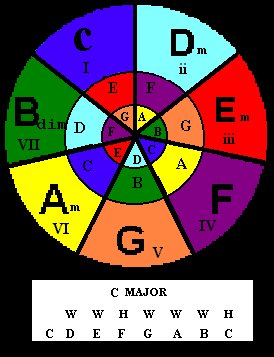Chord Formula’s And Progressions
The table below illustrates the Key of C Major
| C |
Dm |
Em |
F |
G |
Am |
B dim |
C |
| 1 |
2 |
3 |
4 |
5 |
6 |
7 |
|
| I | ii | iii | IV | V | vi | vii | |
| Tonic | Supertonic | Mediant | Subdominant | Dominant | Submediant | Leading tone |
To use the illustration above, you must understand the numbering system. Look above and notice the number under the C. You will note the number (1) and also the roman numeral (I). Each note of the major key has a number to represent it. The C =1 or I, the D = 2 or ii, the E =3 or iii, the F = 4 or IV, the G = 5 or V, the A = 6 or vi and the B = 7 or vii.
You can use the lower illustration to play a number of different progressions. I would like to explain the Blues progression I, IV, V, which is one of the most popular used, to become familiar with this system. A popular blues Progression is 1, 4, 5. In the key of C the chords would be C, F and G. Look below at the 1, 4 and 5 chords. The 1, 4 and 5 chords are the C, F and G. Roman numbers are usually illustrated to show each note of a particular major key. It would be a good idea to become familiar with this technique. The small letters, (ii, iii, vi) represent minor chords. Look below at the Dm, Em and Am chords.
|
C |
Dm |
Em |
F |
G |
Am |
B dim |
C |
|
1 |
2 |
3 |
4 |
5 |
6 |
7 |
|
| I | ii | iii | IV | V | vi | vii | |
| Tonic | Supertonic | Mediant | Subdominant | Dominant | Submediant | Leading tone |
|
Here are some chord progression units in Major Keys, (Chords are Triads). |
||||||||||||||||||||||||||
| { I
V I V} { I IV I IV} { I IV V V} { I IV V IV}
|
You can play these progressions in every major key. The key of C has been illustrated, but play them in other keys. |
{ I V
IV I} { I V IV V}
|
||||||||||||||||||||||||
|
Here are some chord progression units in Major Keys, (Chords are Triads). |
||||||||||||||||||||||||||||||||||
| { I
ii I ii} { I ii iii I} { I ii iii ii} { I ii iii IV}
|
You can play these progressions in every major key. The key of C has been illustrated, but you can convert all of these chords to other keys. | {
I ii
iii V} { I ii iii vi} { I ii IV I} { I ii V I}
|
||||||||||||||||||||||||||||||||
 |
|
Major Chord Formulas
|
(9) = 2 (11) = 4 (13) = 6 |
Minor Chord Formulas
|
seventh------------1, 3, 5, b7 ninth---------------1, 3, 5, b7, 9 eleventh-----------1, 3, 5, b7, 9, 11 thirteenth---------1, 3, 5, b7, 9, 13 diminished--------1, b3, b5 full diminished----1, b3, b5, bb7 half diminished---1, b3, b5, b7 |
Assignments:
| Play the root 6 and root 5 bar chords. | |
| Use the uppermost table to play a 1, 4, 5 progression using the root 6 and root 5 bar chords. | |
| This progression would use the C, F and G chords. Start at the 8th fret, root 6 or E type for the C. Use the root 5 or A type for the F and G chords, 8th and 10th frets A string. | |
| Record these chords on cassette and play the Am pentatonic root fret and the next position starting on the C note 8th fret. | |
| Drum Track | |
| Look over the Major progression chart and begin to record your progressions on a tape recorder. | |
| Learn the C major or what is called the C Ionian mode. |
Good Luck,
From the Jam Room

